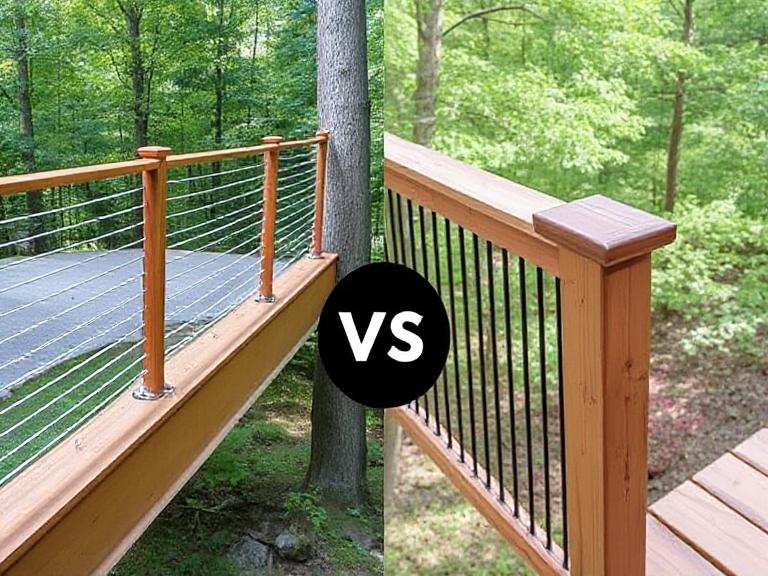Table of Contents
- Introduction
- Cost Comparison Overview
- Material Cost Breakdown
- Installation Costs: DIY vs. Professional
- Maintenance and Longevity
- Aesthetic and Design Considerations
- Senmit Surface Mount Cable Railing Post Overview
- Use Case Analysis: When Cable Wins
- Summary Table: Cable vs. Wood Railing
Introduction

When considering a new railing system for decks, stairs, or balconies, the choice often comes down to two popular options: cable railing versus wood railing. While wood has a timeless appeal, cable railing systems—especially stainless steel options like the Senmit Surface Mount Cable Railing Post—offer a modern, durable alternative. But is cable railing cheaper than wood? This guide breaks down the costs, aesthetics, and maintenance to help you decide.
Cost Comparison Overview
The cost of any railing system includes materials, installation, and long-term maintenance. Here's a high-level comparison:
- Cable railing upfront cost: Slightly higher than wood (mostly due to stainless steel posts, fittings, and cables).
- Wood railing upfront cost: Lower for softwoods (like pine), but costs rise with hardwoods (like ipe or redwood).
- Long-term maintenance: Cable railings require less upkeep, potentially lowering lifetime cost.
Material Cost Breakdown

1. Cable Railing Material Costs
- Stainless Steel Posts (e.g., Senmit): $60–$90 each
- Cable Wire (per linear foot): $0.50–$1.50
- Fittings/End Tensioners: $10–$25 per run
- Total (per linear foot): $40–$80 depending on configuration
2. Wood Railing Material Costs
- Pine or pressure-treated posts: $15–$30 each
- Hardwood posts (e.g., ipe, cedar): $50–$100+
- Balusters & rails: $20–$40 per linear foot
- Total (per linear foot): $25–$60 (depending on wood type)
Installation Costs: DIY vs. Professional
Cable Railing Installation
- DIY is feasible with modular systems like Senmit cable posts
- Professional labor: $50–$100 per linear foot
Wood Railing Installation
- DIY is straightforward with woodworking tools
- Professional labor: $30–$70 per linear foot
Conclusion:
Cable railing may cost more upfront in both materials and labor, but ease of maintenance can balance this long-term.
Maintenance and Longevity
Wood Railing
- Requires annual sealing or staining
- Susceptible to rot, splitting, and pests
- Replacement needed every 10–15 years for softwoods
Cable Railing
- Minimal maintenance: periodic cleaning and tension checks
- Stainless steel (e.g., Senmit posts) is corrosion-resistant
- Can last 30+ years with proper care
Aesthetic and Design Considerations
- Cable railing: Sleek, modern, and maximizes views—ideal for coastal homes and contemporary designs
- Wood railing: Traditional, cozy look—best for cabins, craftsman homes, or rural aesthetics
Senmit Surface Mount Cable Railing Post Overview

The Senmit Surface Mount Cable Railing Post is a durable, premium choice for modern railing projects.
Key Features:
- Material: 304 stainless steel, powder-coated in matte black
- Post Sizes: 36" or 42" height, 2" x 2" square base
- Installation: Includes lag screws, anchor bolts, foot cover, and bracket for easy mounting
- Post Types: End, Intermediate, Corner, Stair-specific posts available
- Applications: Residential decks, commercial balconies, and staircases
Why it’s cost-effective: Although higher upfront, Senmit's pre-drilled, modular posts make DIY installations faster and reduce long-term labor costs.
Use Case Analysis: When Cable Wins
1. Modern Home Renovations
- Homeowners often choose cable for an open feel and updated look
- Ideal for maximizing ocean or mountain views
2. Coastal or Humid Climates
- Wood may warp or degrade faster
- Stainless steel like Senmit’s 304 grade offers superior corrosion resistance
3. Long-Term Investment Properties
- Cable systems retain aesthetics longer
- Minimal upkeep appeals to property managers and HOAs
4. High-Rise or Commercial Installations
- Cable offers better wind resistance and open sightlines
- Senmit’s anti-loosening lag screws and post anchoring ensure safety compliance
Summary Table: Cable vs. Wood Railing
| Feature | Cable Railing | Wood Railing |
|---|---|---|
| Initial Cost | Higher ($40–$80/linear ft) | Lower ($25–$60/linear ft) |
| Maintenance | Low – occasional cleaning | High – annual staining/sealing |
| Durability | 30+ years (stainless steel) | 10–15 years (softwood) |
| Appearance | Modern, sleek, open views | Warm, traditional, rustic |
| DIY Installation | Moderate – Senmit kits simplify it | Easy – basic carpentry skills |
| Best Use Case | Modern homes, coastal areas, decks | Cabins, porches, traditional builds |
Conclusion: While cable railing systems like those using Senmit Surface Mount Posts can be more expensive upfront, they offer greater durability, modern aesthetics, and lower maintenance costs, making them a smart long-term investment for many homeowners.





